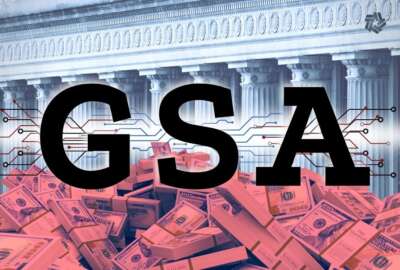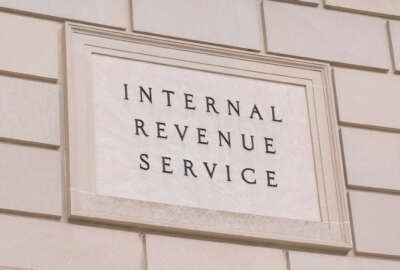How VA’s flagship app got to 2M downloads in less than 3 years
Veterans can use VA’s health and benefits app to view upcoming appointments, message their doctors, manage their prescriptions, and more.
The Department of Veterans Affairs is giving veterans more options to get health care and benefits from the department — in some cases, through just a few taps on their smartphones.
VA’s nearly three-year-old health and benefits app recently saw more than 2 million total downloads. The app also surpassed more than a million monthly users.
Among its features, the app allows veterans to message their doctors, view upcoming health care appointments and check the status of benefits claims.
VA’s app has a 4.8-star rating on Apple’s App Store, with over 138,000 ratings, and is at 4.6 stars on Google Play, based on nearly 40,000 reviews. Those positive ratings are on par with apps such as Uber or Amazon.
Charles Worthington, VA’s chief technology officer and chief AI officer, said the app’s launch stemmed from the department’s 2018 relaunch of VA.gov and the “culmination of VA’s digital modernization effort.”
Worthington said the idea of a VA app started when VA’s Office of Information and Technology noticed a greater percentage of VA.gov traffic came from smartphones each year.
More than half of all federal website users use mobile devices.
“We saw this trend, and it led us to ask ourselves, and ultimately to ask veterans,” Worthington said. “Even though we had invested a lot of energy in making VA.gov an easy-to-use website on mobile phones, we wanted to ask ourselves the question: Is this the best experience we can provide to smartphone users?”
Christopher Johnston, VA’s deputy chief technology officer for digital experience, said younger generations of veterans are driving demand for mobile-first digital services at the VA.
“Today’s veterans are very tech savvy, and they want to be able to access these things … in the grocery store, or at the beach with their family, or when it occurs to them, in a very, very quick and easy way,” Johnston said.
Among its features, veterans can use the app to view upcoming appointments, message their doctors and manage their prescriptions.
Veterans can also upload photos of documents and submit them as part of the disability benefits claim process. In some circumstances, the VA requests more information from veterans to complete their claims.
“The old way that would have worked is the VA sends a letter, saying, ‘Hey, we’ve got your claim. But there’s this missing piece of evidence’ — maybe a marriage certificate, or could be anything. And when the veteran receives that letter, they read it, and then they can mail it back. And you can obviously imagine how much faster that is, if suddenly now you can see in your claim status, ‘Oh, there’s this piece of evidence missing.’ And right there in the app, you can upload a document, you can take out your camera, you can take a picture of the document, hit send, and suddenly a transaction that previously would have taken days can be done in seconds,” Worthington said.
The VA OIT team said providing a higher level of customer service to veterans is part of what’s leading to higher trust scores across the department.
The VA announced last month that veteran trust scores in the department reached an all-time high of more than 80%. That’s up from 55%, when the VA first conducted this survey in 2016.
The VA is basing its scores on survey responses from more than 38,000 veterans who obtained VA services between January and March this year.
“The VA is a big place, but efforts like this are a small reason for those improvements in trust. It’s meeting veterans where they are and trying to make it easier for them to access the benefits of certain services that they’ve earned,” Worthington said.
In user feedback sessions, veterans told the VA they valued the simplicity and ease of quickly accessing some of the most common services on VA.gov — and the ability to access those services from their phones. VA soft-launched the app in August 2021.
“We put it in the app store, but didn’t make a lot of noise about it, because obviously, we try to pilot things early in their development. And over time, we have added features and become much more public about the app,” Worthington said.
Johnston said some veterans also prefer the app because they can get push notifications.
“You can imagine that I get a push notification that says your doctor has responded to your message. I look at my phone, I’m logged in instantly. I see that response to my doctor while I’m standing in line at the grocery store. It’s all very quick and happens instantly, and reduces a lot of anxiety for veterans who are frequently waiting for responses from VA.,” Johnston said.
After logging in with a username and password or another credential, veterans can log into the app quickly using Face ID or using their fingerprint for the next 45 days.
“It’s a faster login process, once you’ve done it that first time with whichever credential you use, the same that you would use on VA.gov,” Worthington said.
Johnston said the VA OIT is making sure veterans experience a seamless transition between VA.gov and the smartphone app.
“We’re not rewriting the same things over and over again. The secure messaging system is the same secure messaging system that’s on VA.gov. It’s the same database, it’s the same business logic. It’s the same delivery groups that you can choose, and what we’re doing is creating a native mobile layer on top that reaches that same database,” Johnston said.
“It’s a lot easier for them to just open the app and get right into messaging their doctor or checking their appointments, maybe a claim status. That was one feature that people were really excited about.”
Rachel Han, a product lead with the U.S. Digital Service working with VA OIT, said the team focused on reducing the amount of time it takes for veterans to access some of the VA’s most commonly sought services.
“We really want to make sure, for example, with push notifications, or the human-centered design process, that we reduce the number of clicks and reduce the amount of time work overall,” Han said.
Han said the app also supports assistive technology, such as text-to-voice tools.
“We want to make sure that this experience is really simple for everyone. We want to make sure that the letters that veterans get from the VA can be read by mobile phone to these veterans, and that they wouldn’t have to wait in the mail for a physical letter, or ask someone who can see to read that letter to them,” she said.
Worthington said VA OIT always ensures veterans who need assistance technologies are part of the user-testing phase of the app’s features.
“That’s a real way to know for sure how well the tools are working,” he said.
The VA is looking to roll more to the mobile app later this year. They include improvements to how veterans submit travel claim submissions, in order to be reimbursed for traveling to appointments, as well as improvements to the process of submitting a disability claim.
“Those are some of the highlights that we’re looking forward to this coming year,” Worthington said.
Copyright © 2025 Federal News Network. All rights reserved. This website is not intended for users located within the European Economic Area.
Jory Heckman is a reporter at Federal News Network covering U.S. Postal Service, IRS, big data and technology issues.
Follow @jheckmanWFED






